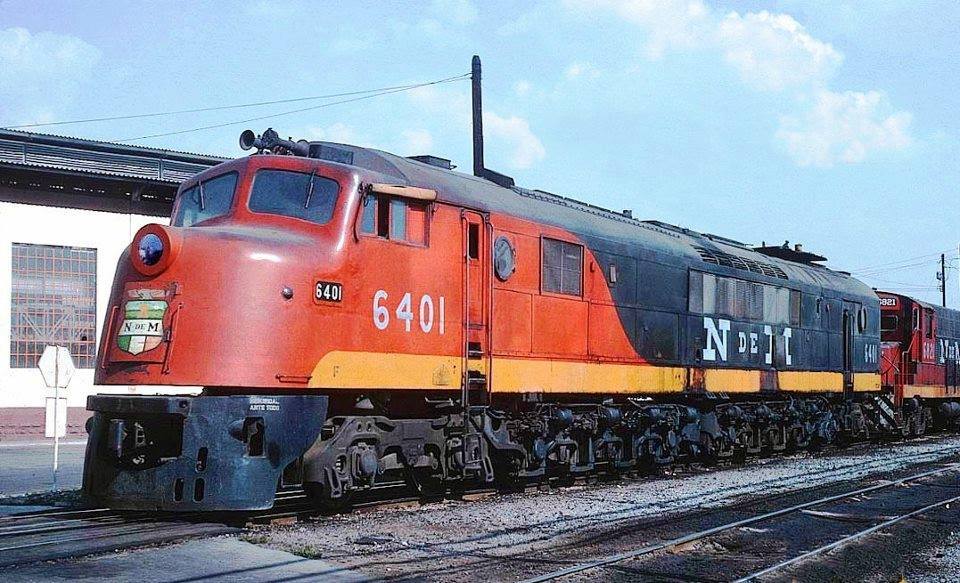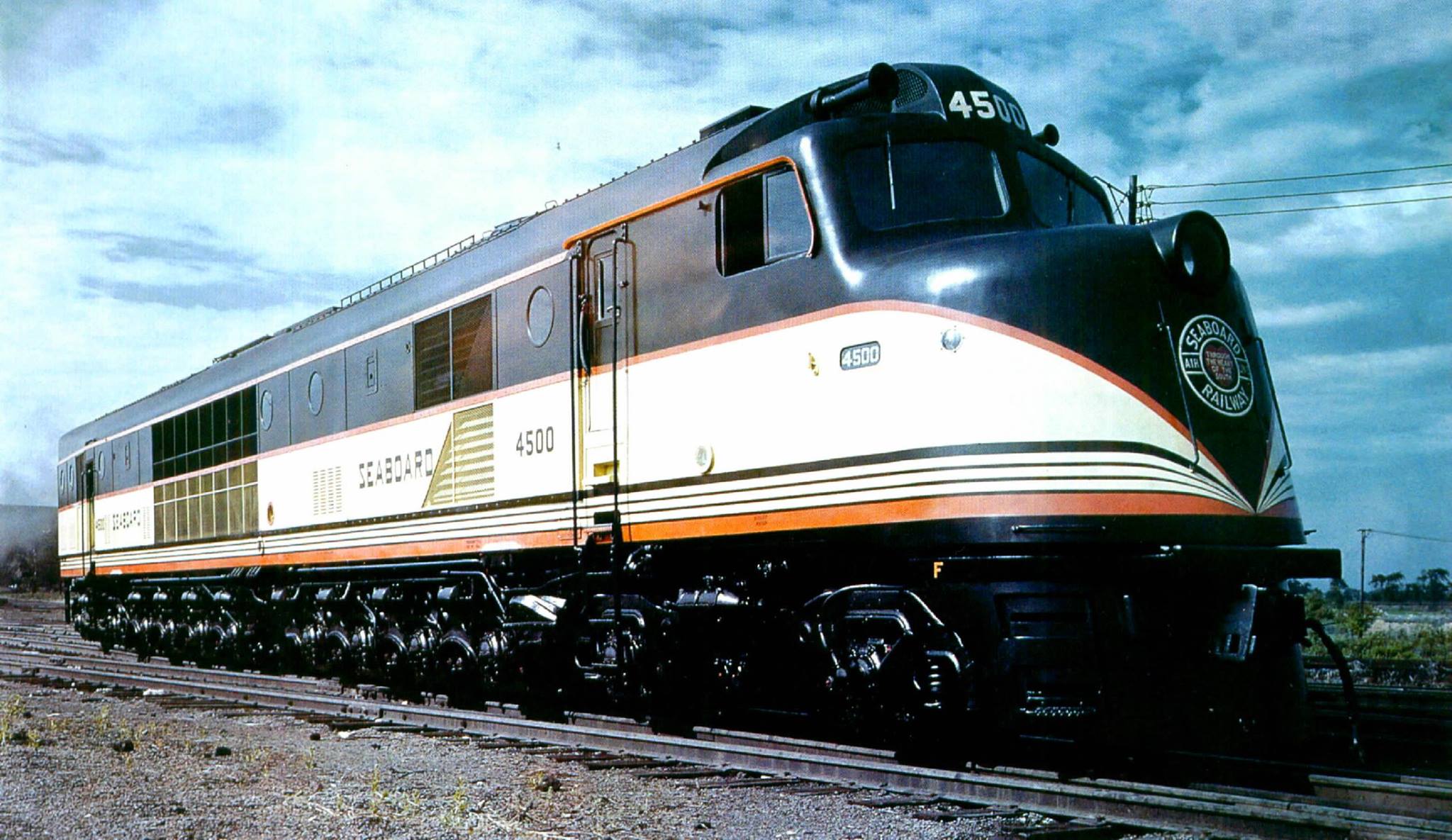One of the most freakish locomotives to roam US rails. Baldwin called them a DR-12-8-1500/2, but to railroaders, they were "Centipedes" due to all those "legs"

One of the most freakish locomotives to roam US rails. Baldwin called them a DR-12-8-1500/2, but to railroaders, they were "Centipedes" due to all those "legs"

Baldwin tended to use a naming convention similar to Nissan engines. All the info was right there in the name, you just needed to know how to decipher it. So, the DR-12-8-1500/2 was a Diesel Road locomotives with 12 axles, 8 powered axles and 2 engines rated at 1500hp. They were big (91 feet long), heavy (593 tons) and had a whole lot of tractive effort (205,000lbs starting, 105,600 continuous). And they were a sales failure, with Seaboard Air Line buying 14, Pennsylvania buying 22 and Nacional de Mexico buying 14.


While NdeM and SAL preferred to run theirs as single units, the PRR ordered their Centipedes semi-permanently attached in back-to-back pairs, for a single 180+ foot 6000hp unit. The PRR had planned to run them in passenger service, but their reliability and tendency to abuse the roadbed led them to be downgraded to strictly pusher service on steep grades.
PRR "Centipedes" in the retirement line, ready for scrap after only 16 years of service. They have been white-striped, referring to the strikeout through the numbers signifying their removal from the roster. The PRR was arguably the most patient with theirs, as the SAL and NdeM units had pretty short careers. None were saved for posterity.

How the PRR's Centipedes spent their last days, shoving on the end of trains through Horseshoe Curve.

So, why was the Centipede such a failure? It's size and weight was a big part of it. You needed roadbed that could support them and facilities that could accomodate them, and they were murderous on infrastructure. But a big reason was also just that they were Baldwins, and Baldwin never seemed to understand the diesel market. Their De La Vergne powerplants were never that reliable and Westinghouse electrical gear was always second-rate to GE's. Baldwin also tried to build diesels like they built steam locomotives, never really standardizing the process. Component locations and wiring and air line routing and other parts varied from unit to unit, making diagnosis and repair a frustrating process. And Baldwin failed to offer multiple unit capability that was compatible with other manufacturers, as well as never offering dynamic braking (like an EV/hybrid's regenerative braking except the generated power is dissipated through resistor grids in the roof).
This lead to the exact chain of demotions on the PRR. Originally intended for passenger use, the reliability troubles and how hard they were on the track at speed led to them getting bumped to drag freight service. But then the lack of dynamic braking meant they had a hard time slowing heavy trains on downgrades and if they needed more power, they either had to use more Baldwin units or use other brand locomotives with a second crew. So then they got bumped to just shoving trains over huge grades at low speed.

In reply to Pete Gossett :
Yep. Looking up SPMW 8207 and 8208 shows that they are F7Bs that had their traction motors removed but still retain their prime mover and generator. The rotary plows were originally steam powered but have been converted to electric and the B-units provide the power. Also, interesting to see that they still have SP lettering (SPMW, Southern Pacific Maintenance of Way) considering the UP absorbed Southern Pacific 15 years ago.

3 of the Central Railroad of New Jersey's Fairbanks-Morse H24-66 "Trainmasters" at Elizabethport, NJ in 1965

DL&W Trainmasters in Scranton, PA. Fairbanks-Morse contracted Raymond Loewy to do all their styling, and the result was rather subdued for Loewy. Still good-looking, but not as extravagant as some of his other works.
F-M joined the carbody unit game a little later than most, with the Erie-Builts in '49. These were followed by the unusual Consolidated Line in '50. Unlike EMD, who's freight (F-units) and passenger (E-units) were completely different, Fairbanks-Morse built both their freight and passenger cabs on the same body and frame, with different powertrains and trucks. The freight units (called CFAs) had a choice of 1600hp or 2000hp engines and 2 B (2-axle) trucks. The passenger units (called CPAs) had 2000hp or 2400hp engines and, oddly, a B truck in the front and an A-1-A truck in the rear (outer axles powered, center axle unpowered) for supporting the weight of the steam generator for passenger use.

The C-Liners were not a huge success. Railroads were always leery of how different Fairbanks-Morses were, particularly in the engine department, and the Westinghouse electrical components, particularly the generators, were prone to failure. They also came out at a time when the carbody-style locomotive was on its way out.

Canadian Pacific was one of the last to still have C-Liners still in service, and the only 2 surviving examples both are ex-CP units.

Canadian Pacific #4744, a 1-of-1 Montreal Locomotive Works M640. MLW was Alco's Canadian arm, and their M-series was the equivalent of the US' Century Series. That means this was a 4000hp monster, using a one-off V18 (the 3600hp C636's used a V16)

The posts above about snow plows made me recall a story I read in "The Mainstreeter".
The Northern Pacific had a steam powered rotary snow plow named Rotary No. 6. I did a quick search and found photos of #2 and #10, I expect #6 was similar to these.
Here is #10:

Anyway, back in the later 60's, NP had rotary #6 in use on their Grangeville, ID branch. For whatever reason they needed to move the plow up to Spokane, WA and they chained it to the rear of the daily train between Lewiston, ID and Spokane named "The Highball". I'm guessing the plow was not able to be turned around so it could be coupled to the train, but instead was heading the same direction as the train, and there would be no way to couple it to a train on the front of the plow. Lewiston is the lowest point in the state of Idaho at only 745 ft. Moscow, ID which is about 30 miles north of Lewiston is a bit over 2500 ft, so the tracks did not take a direct route to get up the grade. While going up of the grades known as Kendrick Mountain, one of engines pulling the train ran out of fuel and the train stalled on the grade. The power was cut off and ran up the 2.4% grade to Troy, ID to refuel. They came back to the train and started on their way, but they did not make a gentle start and the chains holding the plow onto the rear of the train let go. The plow rolled back down the hill, picking up speed until it went off the tracks in a curve at Bear Canyon. A few cars ahead of the caboose also broke loose, so the wreckage of the plow ended up covered with frozen peas and the remnants of a couple reefer cars. The enginemen reportedly were not all that upset to see the plow's demise as it was steam powered and one had to shovel coal into it to the point of exhaustion.
The tracks between Arrow, ID and Moscow, ID are long gone, but having been to that area, I would've love to see trains in operation there. When I was there in the mid 90's the tracks from Spokane ended in Moscow. Now they don't even go that far.

Found some pics of No. 6. Here it is in Lewiston, ID in 1947.

Here it is when it was nearly new in 1902 at Wallace, ID.

And finally at Willow Creek, MT in 1936.
You'll need to log in to post.